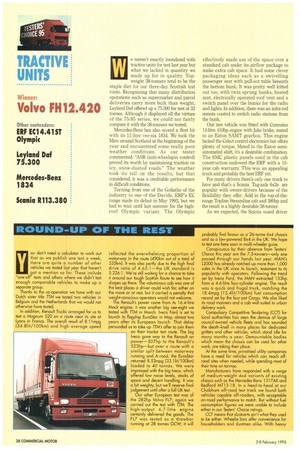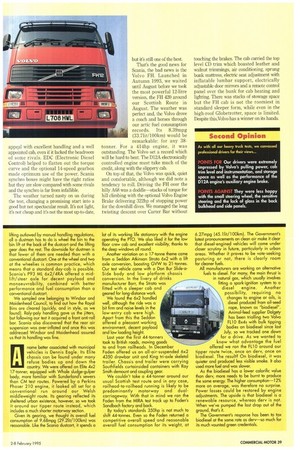ou don't need a calculator to work out that as
Page 40

Page 41

If you've noticed an error in this article please click here to report it so we can fix it.
we publish one test a week, there are quite a number of other vehicles we tested last year that haven't got a mention so far. These include "one-off" tests and others where we didn't test enough comparable vehicles to make up a separate group. Thanks to the co-operation we have with our Dutch sister title TTM we tested two vehicles in Belgium and the Netherlands that we would not otherwise have tested.
In addition, Renault Trucks arranged for us to test a Magnum 520 on a route near its site at Lyons in France. The overall result of 8.11mpg (34.81it/100km) and high average speed reflected the overwhelming proportion of motorway in the route (490km out of a total of 535km). It was also partly due to the high final drive ratio of 4,65:1—the UK standard is 5.226:1. We're still waiting for a chance to take it around our tough Scottish Route to see how it shapes up there. The voluminous cob was one of the best places a driver could wish for, either on the move or at rest, but it carried a penalty that weight-conscious operators would not welcome.
The Renault's power came from its 16,4-litre Mack engine; it was another big vee-eight we tested with TIM in March. Iveco Ford is set to launch its flagship EuroStar in May, almost two years after its European launch. That delay persuaded us to take up TTM's offer to join them on their tractor test route. The big Iveco gave way to the Renault on power-507hp to the Renault's 523hp—but over a route with a similar split between motorway running and A-road, the EuroStar returned 8.53mpg (33.11it/100km) loaded to 40 tonnes. We were impressed with the big Iveco, which offered low noise levels, stacks of space and decent handling. It was a bit weighty, but we'll reserve final judgement until after a full UK test.
Our other European test was of the 282hp Volvo FL7, again we carried out the test with TIM. The high-output 6.7-litre engine certainly delivered the goods. The FL7 was tested as a drawbar running at 28 tonnes GCW; it will probably find favour as a 26-tonne 6x4 chassis and as a low-powered 8x4 in the UK. We hope to test one here soon in multi-wheeler guise.
Conspicuous by their absence from Testers' Choice this year are the 7.5-tanners—only one passed through our hands last year. MAN's L2000 has already notched up more than 1,000 sales in the UK since its launch, testament to its popularity with operators. Following the trend set by Iveco Ford, the MAN extracted 153hp from a 4.6-litre four-cylinder engine. The result was a quick and frugal truck, matching the 18.4mpg (15.41it/100km) fuel consumption record set by the four-pot Cargo. We also liked its road manners and a cab well-suited to urban delivery work.
Compulsory Competitive Tendering (CCT) for local authorities has seen the demise of large council-owned vehicle fleets and has sounded the death-knell in many places for dedicated gritters and other vehicles, which stand idle for many months a year. Demountable bodies which mean the chassis can be used for other work, are taking their place. At the same time, privatised utility companies have a need for vehicles which can reach offroad sites when needed, while spending most of their time on tarmac.
Manufacturers hove responded with a range of medium-weight 4x4 variants of existing chassis such as the Mercedes-Benz 1317AK and Bedford MT13-18. In a head-to-head at our Chobham off-road test track we found both vehicles capable off-rooders, with acceptable on-road performance to match. But without fuel consumption figures we were unable to include either in our Testers' Choice ratings. CCT means that dustcarts ain't what they used to be either. Wheelie bins offer convenience for householders and dustmen alike. With heavy
lifting outlawed by manual handling regulations, all a dustman has to do is wheel the bin to the bin lift at the back of the dustcart and the lifting gear does the rest. The downside for dustmen is that fewer of them are needed than with a conventional dustcart. One at the wheel and two at the wheelies is common practice, which means that a standard day-cab is possible. Scania's P93 MI. 6x2/4RA offered a micllift/steer axle for decent payload and manoeuvrability, combined with better performance and fuel consumption than a conventional dustcart.
We sampled one belonging to Windsor and Maidenhead Council, to find out how the Royal Bins are cleared (quickly, and in style, as we found). Roly-poly handling gave us the jitters, but following our test it acquired a front anti-roll bar. Scania also discovered that the rear air suspension was over-inflated and once this was addressed Windsor and Maidenhead assured us that its handling was fine.
name better associated with municipal vehicles is Dennis Eagle. Its Elite chassis can be found under many refuse bodies up and down the country. We were offered an Elite 4x2 17-tonner, equipped with Whale sludge-gulper body, more familiar with Sunderland's sewers than CM test routes. Powered by a Perkins Phaser 210 engine, it looked all set for a conventional run around our Welsh middleweight route. Its gearing reflected its sheltered urban existence, however, so we took it around our tipper route instead, which includes a much shorter motorway section. Given its gearing, we thought its overall fuel consumption of 9.68mpg (29.21it/100km) was reasonable. Like the Scania dustcart, it spends a
lot of its working life stationary with the engine operating the PTO. We also liked it for the low floor crew cab and excellent visibility, thanks to the deep windows all round.
Another variation on a 17-tonne theme came from a Seddon Atkinson Strato 6x2 with a lift axle conversion, boosting GVW to 21-tonnes. Our test vehicle come with a Don Bur Slide-aSide body and low platform chassis conversion. In the livery of drinks manufacturer Barr, the Strata was Fitted with a sleeper cab and geared for long-distance work. We found the 6x2 handled well, although the ride was a bit firm and noise levels in the low-entry cob were high. Apart from this the Seddon offered a pleasant working environment, decent payload and low loading height. Last year the first 44-tonners took to British roads, moving goods to and from railheads. In December Foden offered us an all-air-suspended 6x2 4350 drawbar unit and King tri-axle skeletal trailer. Chassis and trailer were carrying Southfields curtainsided containers with Ray Smith demount and coupling gear. We couldn't take a 44-tonner around our usual Scottish test route and in any case, railhead-to-railhead running is likely to be predominantly motorway and dualcarriag_eway. With that in mind we ran the Foden From the MIRA test track up to Foden's Sandbach factory and back. By today's standards 350hp is not much to shift 44-tonnes. Even so the Foden returned a competitive overall speed and reasonable overall fuel consumption for its weight, at 6.27mpg (45.114/100km). The Government's latest pronouncements on clean air make it clear that diesel-engined vehicles will come under closer scrutiny in future, particularly in urban areas. Whether it proves to be vote-seeking posturing or not, there is clearly room For cleaner fuels.
All manufacturers are working on alternative fuels to diesel. For many, the main thrust is in natural gas, which usually involves fitting a spark-ignition system to a diesel engine. Another possibility, requiring no changes to engine or oils, is diesel produced from oil-seed rape, known as "biodiesel". Animal-feed supplier Dalgeiy has been trialling two Volvo FL10 8x4s with bulk tipping bodies on biodiesel since last July, so we tracked one down for a drive. As we wanted to know what advantage the fuel offered we ran the Fll 0 around our tipper route twice, once on derv, once on biodiesel. The result? On biodiesel, it was quieter and produced less visible smoke. It also used more fuel and was slower.
As the biodiesel has a lower calorific value than derv, more needs to be burnt to produce the same energy. The higher consumption-12% more on average, was therefore no surprise. Power losses could be restored by engine adjustments. The upside is that biodiesel is a renewable resource, whereas dery is not. When we've pumped the last drop out of the ground, that's it. The Government's response has been to tax biodiesel at the some rate as derv—so much for its much vaunted green credentials.
































































































